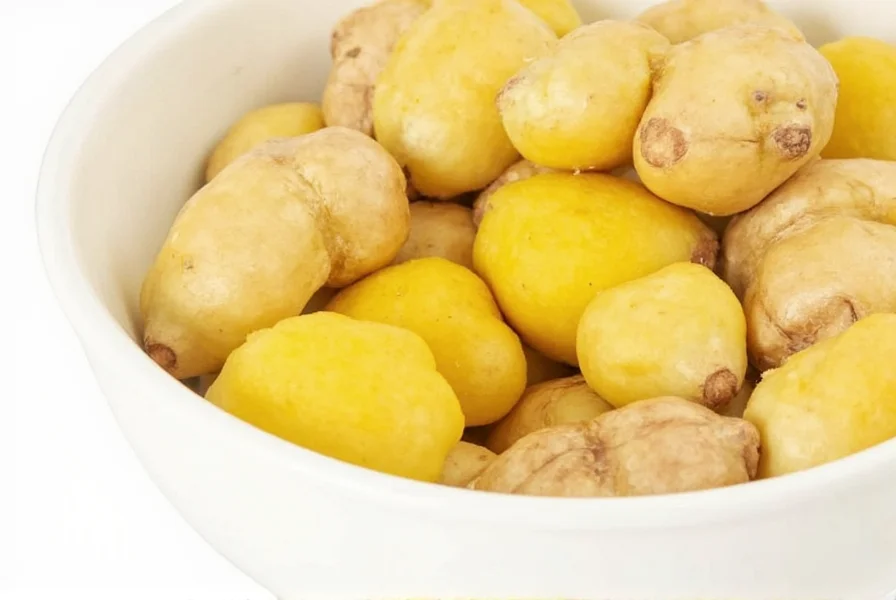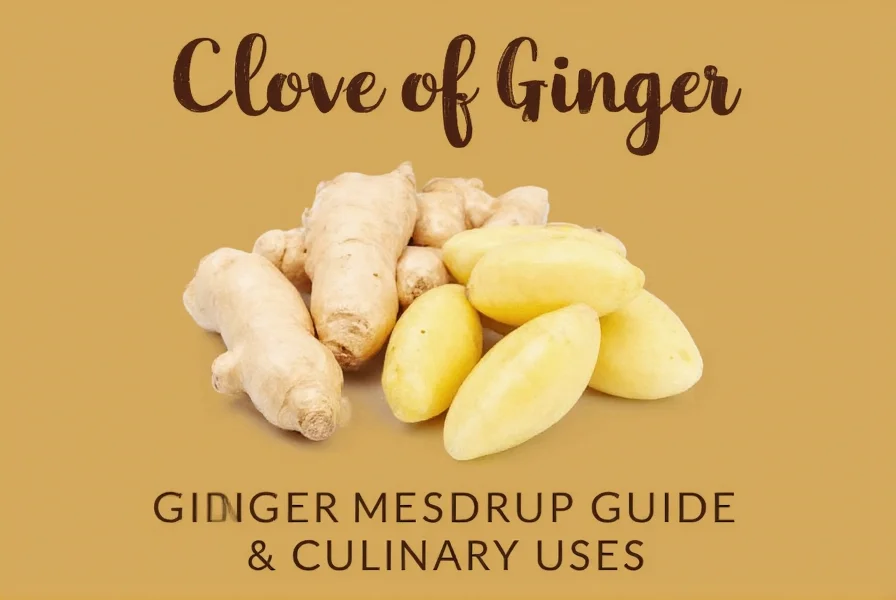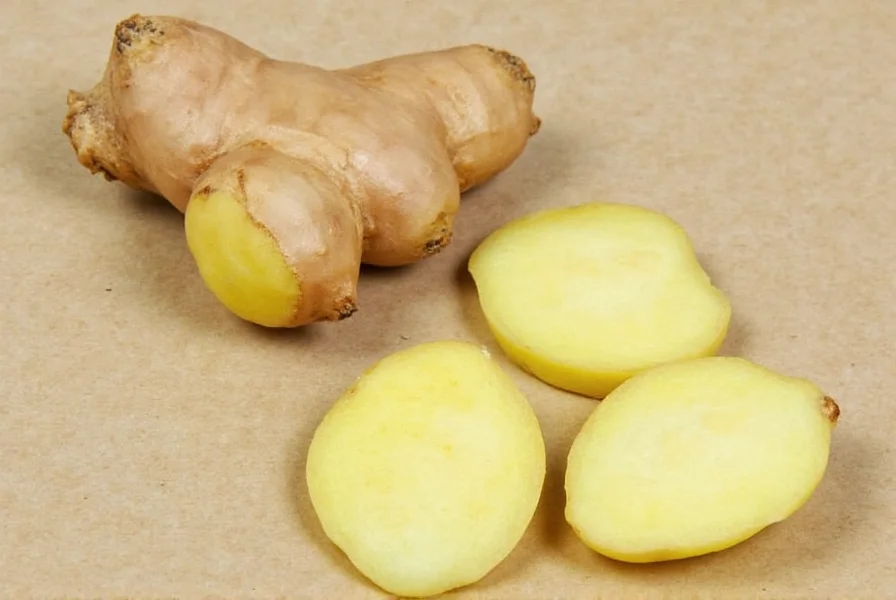Contrary to common misconception, ginger doesn't have cloves like garlic—it grows in knobby sections called rhizomes or fingers. When recipes mention a “clove of ginger,” they typically refer to a 1-inch piece (about 14g), yielding approximately 1 tablespoon of grated ginger. This measurement standard helps home cooks accurately follow recipes without confusion.
Many home cooks encounter confusion when recipes call for a “clove of ginger.” Unlike garlic, which grows in distinct cloves, ginger develops as a continuous rhizome with branching fingers. Understanding this distinction is crucial for accurate recipe execution and maximizing ginger's culinary potential.
Understanding Ginger Anatomy
Ginger (Zingiber officinale) grows underground as a rhizome—a horizontal stem that produces roots and shoots. What we commonly call “ginger root” is actually this aromatic rhizome, composed of multiple interconnected knobs or fingers. Each finger varies in size, typically ranging from 1-4 inches in length.

Standard Ginger Measurements for Cooking
When recipes specify “one clove of ginger,” they're using informal terminology that generally means:
| Ginger Measurement | Weight | Grated Yield | Ground Ginger Equivalent |
|---|---|---|---|
| 1-inch piece (standard “clove”) | 14g | 1 tablespoon | 1/4 teaspoon |
| Small knob | 7g | 1.5 teaspoons | 1/8 teaspoon |
| Large knob | 21g | 1.5 tablespoons | 3/8 teaspoon |
Practical Cooking Applications
Knowing how to properly measure ginger ensures balanced flavor in your dishes. For most savory applications like stir-fries and curries, the standard 1-inch piece provides optimal heat without overwhelming other ingredients. When preparing ginger for recipes requiring what is a clove of ginger equivalent to measurements, follow these professional techniques:
- Peeling: Use a spoon to gently scrape off skin, preserving more flesh than a knife would
- Grating: Microplane graters yield the most aromatic, evenly distributed ginger
- Minced: Finely chop after grating for recipes needing texture
- Infusing: For soups and broths, add whole pieces and remove before serving
Substitution Guidance
When fresh ginger isn't available, proper substitution maintains recipe integrity. Understanding how much ginger is in one clove helps convert to alternatives:
- Dried ginger: 1/4 teaspoon ground ginger replaces 1 tablespoon fresh grated
- Ginger paste: 1/2 teaspoon paste equals 1-inch fresh piece
- Candied ginger: 2 tablespoons chopped replaces 1 tablespoon fresh (reduce added sugar)
- Ginger juice: 1 teaspoon juice substitutes for 1 tablespoon grated
Remember that dried and fresh forms have different flavor profiles—dried ginger offers warmer, more concentrated notes while fresh provides brighter, sharper heat.
Storage Techniques for Maximum Freshness
Proper storage extends ginger's shelf life and preserves its pungent qualities. To maintain quality when working with ginger clove measurement conversion standards:
- Whole rhizomes: Store in a paper bag in the vegetable crisper (up to 3 weeks)
- Peeled ginger: Submerge in sherry or vodka in an airtight container (1 month)
- Grated ginger: Freeze in ice cube trays with water (3 months)
- Dried pieces: Keep in airtight container away from light (6 months)
Common Misconceptions Clarified
Several myths persist about ginger measurements that affect recipe outcomes:
- Myth: All ginger fingers are equal in potency Fact: Older, woodier knobs contain more concentrated flavor than plump, young sections
- Myth: The skin contains most of the flavor Fact: While flavorful, the skin mainly provides fiber—peeling doesn't significantly reduce potency
- Myth: Frozen ginger loses its zing Fact: Properly frozen ginger retains 90% of its volatile compounds for several months
Professional Chef Tips
Mastering fresh ginger to ground ginger conversion ratios elevates home cooking. Chefs recommend:
- Add ginger early in cooking for mellow, integrated flavor
- Stir in fresh grated ginger during the last 2 minutes for vibrant, spicy notes
- Rub ginger directly on foods like fish or chicken for even distribution
- Freeze whole rhizomes then grate frozen for effortless preparation
Understanding these nuances transforms how you approach recipes requiring precise ginger clove measurement conversion, ensuring consistent results whether you're making Thai curry, gingerbread, or homemade stir-fry sauce.

Frequently Asked Questions
Is a clove of ginger the same as a knob of ginger?
No, ginger doesn't have true cloves like garlic. The term “clove” in recipes typically refers to a 1-inch knob of ginger, which is a single finger section of the rhizome. A standard knob yields about 1 tablespoon of grated ginger.
How much ground ginger equals one clove of fresh ginger?
One 1-inch piece of fresh ginger (approximately 14g) equals about 1/4 teaspoon of ground ginger. This conversion is essential when substituting dried for fresh in recipes requiring precise ginger measurements.
Can I substitute minced ginger for grated ginger in recipes?
Yes, but with adjustments. Minced ginger has larger particles than grated, so use 1.5 times the amount of minced ginger when a recipe calls for grated. For example, if a recipe needs 1 tablespoon grated ginger, use 1.5 tablespoons minced for equivalent flavor impact.
Why do some ginger pieces taste stronger than others?
Ginger's potency varies based on age and growing conditions. Older, woodier knobs contain higher concentrations of gingerol (the compound responsible for heat). Younger, plump sections have milder flavor. When following recipes specifying “clove of ginger,” consider the rhizome's maturity for best results.
How can I maximize ginger's flavor in cooking?
Add ginger early in cooking for mellow, integrated flavor, or during the last 2 minutes for vibrant heat. Freezing whole ginger before grating releases more aromatic compounds. For dressings and cold dishes, let grated ginger steep for 15 minutes before using to fully develop its flavor profile.











 浙公网安备
33010002000092号
浙公网安备
33010002000092号 浙B2-20120091-4
浙B2-20120091-4